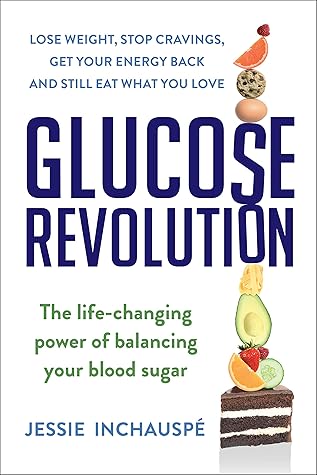More on this book
Community
Kindle Notes & Highlights
Read between
July 1 - July 18, 2023
do you know what the last thing you ate did to your body and mind?
bad.” But science is demonstrating the opposite: processed foods and sugar are inherently bad for us, even if we don’t eat them in caloric excess.
Regulating glucose is important for everyone, diabetes or no diabetes:
In part 2, I describe how glucose spikes affect us in the short term—hunger, cravings, fatigue, worse menopause symptoms, migraine, poor sleep, difficulty managing type 1 diabetes and gestational diabetes, weakened immune system, worsened cognitive function—and in the long term. Dysregulated glucose levels contribute to aging and to the development of chronic diseases such as acne, eczema, psoriasis, arthritis, cataracts, Alzheimer’s disease, cancer, depression, gut problems, heart disease, infertility, PCOS, insulin resistance, type 2 diabetes, and fatty liver disease.
A recent study showed that only 12 percent of Americans are metabolically healthy, which means that only 12 percent of Americans have a perfectly functioning body—including healthy glucose levels.
The “diets” that work are the ones that flatten our glucose, fructose, and insulin curves.
Fiber is often removed from processed foods so that they can be frozen, thawed, and last on shelves for years without losing their texture.
But what the ADA describes as “normal” may not actually be optimal. Early studies showed that the thriving range for fasting glucose may be between 72 and 85 mg/dL. That’s because there is more likelihood of developing health problems from 85 mg/dL and up.
The ADA states that our glucose levels shouldn’t increase above 140 mg/dL after eating. But again, that’s “normal,” not optimal. Studies in nondiabetics give more precise information: we should strive to avoid increasing our glucose levels by more than 30 mg/dL after eating. So in this book I will define a glucose spike as an increase in glucose in our body of more than 30 mg/dL after eating.
Until they do, remember that if the food you ate was sweet and it created a glucose spike, it also created an invisible fructose spike, and that’s what makes a sweet spike more harmful than a starchy spike.
Oxidative stress is a driver of heart disease, type 2 diabetes, cognitive decline, and general aging. And fructose increases oxidative stress even more than glucose alone. That’s one of the reasons that sweet foods (which contain fructose) are worse than starchy foods (which don’t). Too much fat can also increase oxidative stress.
As we eat, we experience more glucose spikes, and insulin rushes in to store excess glucose as fat, which then increases the action of ghrelin. The more weight we put on, the hungrier we get. It’s an unfortunate, vicious, and unfair cycle.
Indeed, Alzheimer’s and glucose levels are so closely connected that Alzheimer’s is sometimes called “type 3 diabetes” or “diabetes of the brain.”
What is the right order? It’s fiber first, protein and fat second, starches and sugars last.


